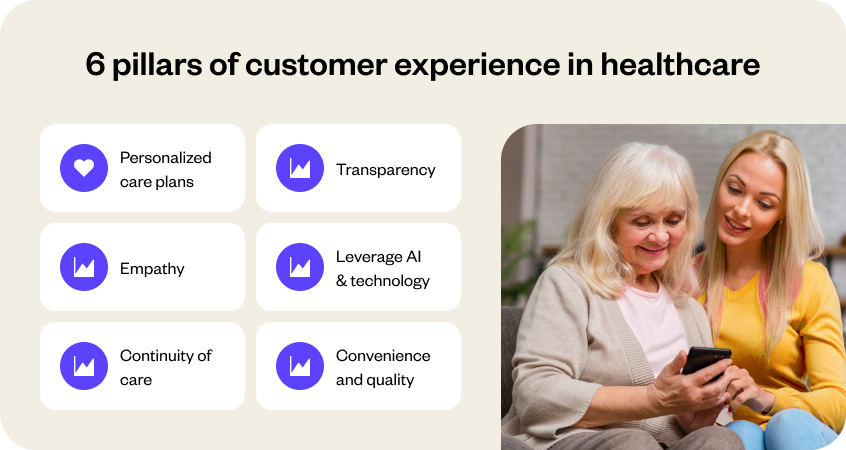Navigating the evolving world of healthcare requires more than medical excellence—it demands outstanding customer experience. This article illuminates the significance of customer experience in healthcare, emphasizing its growing importance. Dive into the nuances of customer experience management in healthcare and discover practical strategies for improving customer experience in healthcare management. As healthcare continues its transformative journey, stay ahead by understanding the latest customer experience trends in healthcare and their implications.
As we traverse through the age of digitalization, it’s crystal clear: patients are not just recipients of medical care—they are empowered consumers. The focus has exponentially pivoted from a myopic view of just health services to a holistic, patient-centric approach. This narrative isn’t just a reactionary adjustment but a proactive metamorphosis, recognizing the valued patronage of each individual. As healthcare expenses soar, the demand isn’t just for excellent medical services but for an elevated, personalized journey. A journey that feels less like a cold transaction and more like an empathetic partnership.
As the Harvard Business Review highlights, a mere 57% of healthcare providers are steering their energies to refine their customer experience. The need of the hour is recognizing the essentiality of effective customer experience management and actively embedding it into the healthcare industry. As the narrative unfolds, we’ll unearth the pillars that bolster this transformation and how technology, like chatbots, is at the vanguard of this revolution.
Related must read:
- Chatbot vs live chat: Which is better for customer service?
- Customer service automation: Full guide
- Customer experience vs. customer service: More than just semantics
- How to improve customer experience?
What is customer experience management in healthcare?
Healthcare, with its myriad divisions—onboarding, administration, insurance, diagnostics, primary care, and more—has historically functioned in siloed environments. This often resulted in a patient’s journey feeling fragmented and impersonal. However, Customer Experience Management (CEM) in healthcare seeks to change that narrative. It’s a strategic approach that centers around understanding, anticipating, and proficiently addressing the needs of patients. The aim? To deliver beyond just medical services. To provide a seamless, empathetic, and cohesive journey that fosters trust and satisfaction.
Technological advancements and the recent pandemic underscored the urgency for this transformation. With healthcare institutions being equated to essential community resources, as highlighted by John A. Quelch, Dean of the Miami Herbert Business School, the shift to a more patient-centric approach is necessary. By addressing tangible factors like wait times and intangible ones like patient comfort, customer experience management ensures that healthcare isn’t just about healing but also about genuinely caring.
The importance of customer experience in healthcare
Navigating the healthcare landscape can often feel like a maze for patients. Current data paints a less than flattering picture: nearly 62% of customers find healthcare services convoluted, while a concerning 95% have encountered negative healthcare experiences. Moreover, two-thirds, or 66%, of patients feel burdened, expressing frustration at managing tasks related to their healthcare needs. This reality shines a glaring spotlight on the pressing need for robust customer experience management (CEM) in the healthcare sector.
But there’s an upside. With effective CEM, healthcare providers can turn the tide. It’s more than just damage control—it’s about seizing opportunities. Effective CEM retains the existing patient base and can pave the way for attracting new ones through positive referrals. It acts as a diagnostic tool, helping identify pain points and tailor services to meet the nuanced needs of individual patients.
By instilling trust and fostering loyalty, healthcare providers can enhance patient outcomes. Moreover, streamlined practices buoyed by CEM can elevate convenience, ensuring patient satisfaction becomes a standard. In a sector where trust and results matter immensely, CEM is indispensable.
6 pillars of customer experience in healthcare
In an age where every choice and preference matters, healthcare providers must harness certain guiding principles. The focus should go beyond elevating just the treatment quality and instead enhance patient satisfaction. These core principles, or pillars, are instrumental in distinguishing a healthcare practice from its competitors. Let’s explore these foundational six pillars that redefine customer experience in healthcare.

1. Personalized care plans
At the heart of exceptional healthcare lies personalization. Each patient walks in with unique needs, medical histories, and lifestyle choices. Providers strengthen the bond of trust by crafting care plans tailored to individual circumstances. This approach transforms the patient-provider relationship from a mere transactional interaction to an enduring alliance built on understanding and mutual respect.
2. Transparency
Trust in healthcare hinges significantly on transparency. From outlining treatment protocols to discussing associated costs, patients yearn for clarity. By facilitating open dialogues about treatment options, potential risks, and expenses, healthcare practitioners cultivate an environment of respect. Such honest and transparent interactions enable patients to make well-informed decisions and foster a deeper sense of trust.
3. Empathy
The healthcare journey is riddled with emotional and physical challenges for patients. Demonstrating genuine empathy can significantly alleviate their concerns. By actively listening, being receptive during tough conversations, and providing a comforting presence, providers can offer more than just medical solutions—they offer emotional solace.
4. Leverage AI and technology
Time is of the essence in healthcare. Providers should weave technology into their CEM strategy to enhance patient engagement and expedite services. AI-driven tools like AI chatbots from platforms such as Yellow.ai, for instance, can facilitate 24/7 patient interactions—from prescription clarifications to symptom assessments. Incorporating such innovations ensures that patients always have a touchpoint, amplifying their comfort and trust.
5. Continuity of care
The healthcare journey isn’t limited to singular interactions. It’s a continuum. Ensuring seamless transitions between medical professionals, maintaining consistent communication, and providing comprehensive post-treatment care are paramount. By championing this holistic approach, healthcare providers can ensure that a patient’s journey is cohesive, organized, and truly therapeutic.
6. Convenience and quality
While healthcare’s primary goal is to heal, the journey to recovery should be as smooth as possible. Providers need to strike a balance between top-tier medical care and unparalleled convenience. Simple initiatives like streamlining appointment bookings, minimizing wait times, and offering telemedicine consultations can significantly impact a patient’s overall experience.
By earnestly integrating these six pillars, healthcare providers can offer a transformative experience that resonates with patient needs and expectations, setting the benchmark for exemplary healthcare delivery.
What are the areas of improvement in healthcare customer experience (CX)?
While some strides have been made In the dynamic landscape of healthcare, there’s still a lot of ground to cover regarding customer experience. Providers striving to position themselves at the pinnacle of healthcare service delivery should laser-focus on these areas for enhancement:
Crafting a seamless experience
Patients expect a fluid journey, free of hiccups, right from the first touchpoint of setting an appointment to the moment they receive their medical reports. A fragmented experience can lead to frustration and potential loss of trust. Leveraging tools like the Yellow.ai platform can smoothen out these rough edges, providing patients with a harmonious experience throughout.

Hyper-personalization
Personalized care isn’t just about tailoring medical treatments; it encompasses the entire patient journey. With the infusion of data analytics, healthcare providers can discern individual preferences, like preferred modes of communication or specific appointment timings. Catering to these seemingly minute details can spell the difference between a standard service and a memorable, patient-centered experience.
Live engagement and assistance
The frequency and quality of interactions can heavily influence a patient’s perspective. Instead of limiting patient-provider communication to scheduled appointments, adopting a more open approach through live engagements, be it via video consultations or real-time chats, can fortify the relationship, especially for patients requiring continual care.
How AI and chatbots improve healthcare customer experience (CX)?
With the rapid influx of technological advancements, staying ahead of the curve is crucial for healthcare providers. Integrating AI and chatbots caters to current demands and paves the way for the future. Here is how these innovations are reshaping the healthcare customer experience:
Chatbots
The market for healthcare chatbots is expected to grow from $230.28 million in 2023 to $944.65 million by 2032. Rightly so, as modern-day healthcare chatbots offer unparalleled advantages. Beyond merely answering FAQs, advanced AI chatbots, especially those powered by platforms like Yellow.ai, can handle intricate tasks like tracking patient recovery progress or providing medication reminders. Their omnipresence ensures patients always have a reliable point of contact, bolstering their confidence in the healthcare provider.
For instance, introducing an AI chatbot in a clinic can book appointments and send post-appointment feedback forms. This twofold approach will streamline the administrative process and garner real-time patient feedback, allowing timely service modifications.
Automation
The healthcare sector is rife with repetitive tasks that, while essential, can consume an excessive amount of time. Automation is a breath of fresh air, ensuring that processes like patient record updates or appointment confirmations are swift, accurate, and hassle-free. Afterall, automation has allowed the healthcare sector to cut administrative costs by $122 billion, according to research group CAQH.
Imagine a leading hospital that incorporated automation for handling insurance claims. It would dramatically decrease errors and accelerate the processing time, leading to increased patient satisfaction and trust.
Medical research for personalized patient experience
AI isn’t limited to administrative tasks—it’s revolutionizing medical research. By sifting through vast datasets, AI can uncover patterns and insights humans might overlook. It means more accurate diagnosis methods and treatments tailored to individual patient’s genetics and health histories.
For instance, researchers might utilize AI to analyze the health records of thousands of patients with rare diseases. The system will identify commonalities and patterns, enabling healthcare professionals to devise more targeted and effective treatment plans.
As healthcare providers transition to more tech-integrated approaches, they improve efficiency and elevate the entire patient experience. The future is here, and those poised to incorporate these advancements stand to redefine customer experience in healthcare.
Why is Yellow.ai the best platform for AI-powered chatbots in healthcare?
Navigating from the transformative powers of AI in healthcare, the question emerges: which platform offers the best capabilities for healthcare institutions? The answer is Yellow.ai. It is an AI-driven ecosystem designed to elevate patient interactions. Here is what sets Yellow.ai apart for healthcare providers:
Human-centric design: Yellow.ai is engineered keeping the end user—patients—in mind. Its user interface is intuitive, ensuring patients can easily interact and get the information they need, irrespective of their tech prowess.
Intelligent voice agents: Yellow.ai’s voice agents aren’t your average bots. They simulate human-like conversations, understand emotions, and adjust responses to match patient sentiments, ensuring a personalized and empathetic interaction.
Integration abilities: Be it CRM or ERP systems, Yellow.ai seamlessly integrates. It ensures real-time responses for patients, from appointment bookings to laboratory test schedules, optimizing patient convenience and efficiency.
Streamlined payments: With the integration of AI, billing becomes a breeze. Patients can quickly process payments, check bills, or even set reminders for pending amounts, ensuring transparent and timely financial interactions.
HIPAA compliance: Yellow.ai ensures that patient data integrity and security are uncompromised, adhering to the stringent standards set by the Health Insurance Portability and Accountability Act (HIPAA).
Final thoughts on healthcare customer experience (CX)
The transformative journey of healthcare, underpinned by technological advancements, emphasizes a reality: the essence of healthcare isn’t merely in treatment but in the entire experiential journey. It’s a realm where technology, empathy, and care converge. Platforms like Yellow.ai are not just tools but partners in this paradigm shift, ensuring that each patient feels valued, heard, and cared for.
For a healthcare journey that resonates with patients and optimizes operational efficiency, take the next step with Yellow.ai. Book a demo today and be at the forefront of this transformative era in healthcare!
Frequently asked questions (FAQs)
What are the types of customer experience?
Customer experience in healthcare is multifaceted, encompassing clinical interactions, efficient operational processes, digital touchpoints like telehealth, the physical ambiance of the healthcare setting, the emotional support patients receive, and post-care follow-ups. Together, these elements shape a patient’s holistic journey, from initial contact through post-treatment, ensuring comprehensive satisfaction in their healthcare experience.
How can consumers’ experience in health care be improved?
Enhancing the healthcare experience entails combining technology and human touch. Leveraging platforms like Yellow.ai can streamline administrative tasks, while healthcare providers must ensure transparent, empathetic, and prompt patient interactions. Continuous feedback and proactive engagement further refine the patient journey.
Why is customer service important to healthcare companies?
With healthcare evolving, patients now have choices and heightened expectations. Stellar customer service retains patients and amplifies reputation through positive word-of-mouth, which is essential in a competitive healthcare landscape.
What is the difference between customer experience and patient experience?
Both customer experience (CX) and patient experience (PX) focus on individuals’ interactions and perceptions with organizations or services. However, there are key differences. CX spans a broad spectrum of industries and encompasses a customer’s entire journey with a brand or service, touching upon product quality, customer service, and overall satisfaction. On the other hand, PX is specific to healthcare and delves into the quality of care, communication with medical professionals, and the overall environment during medical visits. Additionally, the emotional stakes in PX are often much higher due to the personal and sensitive nature of healthcare interactions, requiring greater emphasis on empathy, compassion, and understanding. While both aim to ensure positive interactions and satisfaction, the context and depth of emotional engagement set them apart.
What is the impact of customer experience?
In healthcare, customer experience directly influences patient outcomes and loyalty. Positive experiences lead to better adherence to medical advice and heightened satisfaction, while negative ones can deter timely medical attention. Moreover, in an era of online reviews, a healthcare provider’s reputation hinges on patient feedback. Thus, exceptional patient-centered care is essential for health outcomes and the institution’s standing in the market.






















